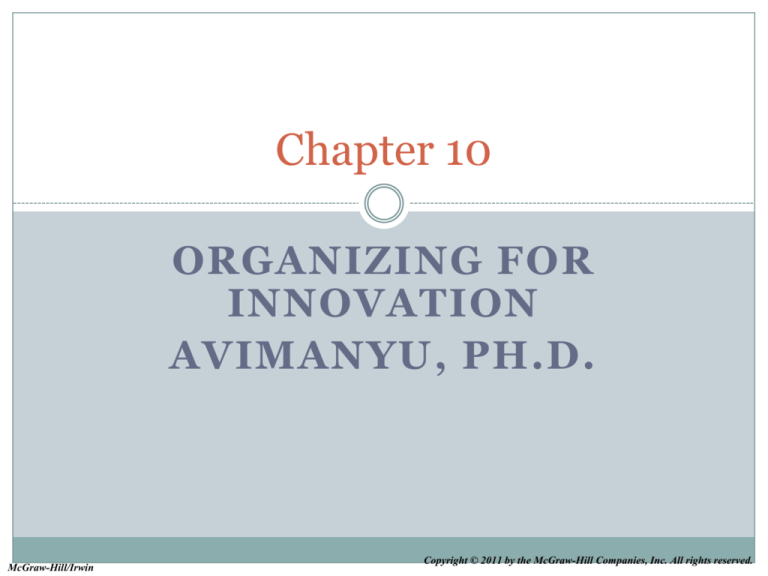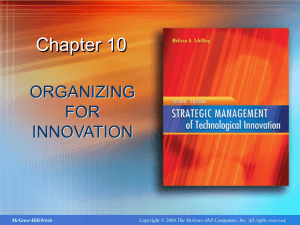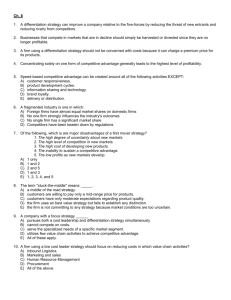
Chapter 10
ORGANIZING FOR
INNOVATION
AVIMANYU, PH.D.
McGraw-Hill/Irwin
Copyright © 2011 by the McGraw-Hill Companies, Inc. All rights reserved.
Overview
A firm’s size and structure will impact its rate and
likelihood of innovation.
Some structures may foster creativity and
experimentation; others may enhance efficiency and
coherence across the firm’s development activities.
There may also be structures that enable both
simultaneously.
Some structural issues are even more significant for the
multinational firm.
Size and Structural Dimensions of the Firm
Size: Is Bigger Better?
In 1940s, Schumpeter argued that large firms would be more
effective innovators
Better
able to obtain financing
Better able to spread costs of R&D over large volume
Large
size may also enable…
Greater
economies of scale and learning effects
Taking on large scale or risky projects
Size and Structural Dimensions of the Firm
However, large firms might also be disadvantaged at innovation because…
R&D efficiency might decrease due to loss of managerial control
Large firms have more bureaucratic inertia
More strategic commitments tie firm to current technologies
Small firms often considered more flexible and entrepreneurial
Many big firms have found ways of “feeling small”
Break overall firm into several subunits
Can utilize different culture and controls in different units
Theory In Action
Xerox and the Icarus Paradox
In Greek mythology, Icarus was so enthralled with his
exceptional wax wings that he flew close to the sun, melting his
wings and crashing to his death.
Icarus Paradox: That which you excel at can be your undoing.
Similarly, in 1960s and 70s, Xerox had such a stranglehold on
the photocopier market, it did not pay attention to new Japanese
competitors making inexpensive copiers.
By the mid-1970s, Xerox was losing market share to the
Japanese at an alarming rate and had to engage in a major
restructuring and turnaround.
Size and Structural Dimensions of the
Firm
Structural Dimensions of the Firm
Formalization:
The degree to which the firm utilizes rules
and procedures to structure the behavior of employees.
Can substitute for managerial oversight, but can also
make firm rigid.
Standardization: The degree to which activities are
performed in a uniform manner.
Facilitates smooth and reliable outcomes, but can stifle
innovation.
Size and Structural Dimensions of the
Firm
Centralization:
The degree to which decision-making authority
is kept at top levels of the firm OR the degree to which activities
are performed at a central location.
Centralized authority ensures projects match firm-wide
objectives, and may be better at making bold changes in overall
direction.
Centralized activities avoid redundancy, maximize economies
of scale, and facilitate firm-wide deployment of innovations.
But, centralized authority and activities might not tap diverse
skills and resources, and projects may not closely fit needs of
divisions or markets.
Some
firms have both centralized and decentralized R&D
activities.
Size and Structural Dimensions of the
Firm
Centralized and Decentralized R&D Activities
Theory In Action
Shifting Structures at 3M
Under McKnight 3M had both a central research laboratory and
decentralized R&D labs. His “grow and divide” philosophy
encouraged divisions to be split into small, independent and
entrepreneurial businesses.
Lou Lehr consolidated the 42 divisions and 10 groups into 4
business sectors. He also established a three-tiered R&D system:
central research laboratories for basic research, sector labs for core
technologies, and division labs for projects with immediate
applications.
Jake Jacobsen encouraged more disciplined project selection and
shifted focus from individual entrepreneurs to teams.
“Desi” Desimone eased company back toward a looser, more
entrepreneurial focus with less centralization.
Size and Structural Dimensions of the Firm
Mechanistic versus Organic Structures
Mechanistic Structures have high formalization and
standardization.
Good
for operational efficiency, reliability.
Minimizes variation may stifle creativity
Organic
structures have low formalization and
standardization; described as “free flowing”
Encourages
creativity and experimentation
May yield low consistency and reliability in manufacturing.
Size and Structural Dimensions of the
Firm
Size versus Structure
Many
advantages and disadvantages of firm size are actually due
to structural dimensions of formalization, standardization, and
centralization.
Large firms typically make greater use of formalization and
standardization because of challenges of oversight.
The Ambidextrous Organization: The Best of Both
Worlds?
Some divisions (e.g., R&D, new product lines) may be small and
organic.
Other divisions (e.g., manufacturing, mature product lines) may
be larger and more mechanistic.
Can also alternate through different structures over time.
Modularity and “Loosely-Coupled”
Organizations
Modular Products
Modularity refers to the degree to which a system’s components
can be separated and recombined.
Products may be modular at user level (e.g., Ikea shelving
systems), manufacturing level (e.g., Sony’s Walkman), or other
levels.
A standard interface enables components to be combined easily.
Modularity can enable many different configurations to be
achieved from a given set of components.
Modularity and “Loosely-Coupled” Organizations
Loosely-Coupled Organizational Structures
Modular products can enable (though do not necessitate) the use of
modular organizations – more typically termed “loosely coupled”
organizational forms.
In a loosely-coupled organization, activities are not tightly integrated;
they achieve coordination through adherence to shared objectives and
standards.
Less need for integration enables firms to pursue more flexible
configurations; may specialize in a few activities and outsource others.
Results in a network of loosely connected firms or divisions of firms.
May not be good when very close coordination is needed, or when there
is high potential for conflict.
Theory in Action
The Loosely-Coupled Production of Boeing’s 787 Dreamliner
The Dreamliner was a super-efficient long-range mid-sized airliner
manufactured primarily from carbon fiber composites that make it
lighter and more fuel efficient.
The aircraft itself was designed as large individual modules that could
be quickly snapped together.
The production process was also more loosely-coupled: Dozens of
partners from around the world built and preassembled large pieces of
the plane which were then delivered to Boeing for final assembly.
The dramatic increase in outsourcing helped to spread the risks of
development, contain costs, and facilitate foreign sales.
On the other hand, the large number of suppliers made coordination
more complex and lead to several delays. Boeing’s management was
considering bringing more of the work back in-house.
Managing Innovation Across Borders
Centralization versus decentralization is a particularly
important issue for multinational firms.
Foreign markets offer diverse resources, and have diverse
needs.
Innovation tailored to local markets might not be leveraged
into other markets.
Customization might make them poor fit for other
markets.
Divisions may be reluctant to share their innovations.
Other divisions may have “not invented here” syndrome.
Managing Innovation Across Borders
Bartlett and Ghoshal identify four strategies of multinational innovation
Center-for-global: all R&D activities centralized a single hub
Tight coordination, economies of scale, avoids redundancy, develops
core competencies, standardizes and implements innovations
throughout firm.
Local-for-local: each division does own R&D for local market
Accesses diverse resources, customizes products for local needs.
Locally leveraged: each division does own R&D, but firm attempts to
leverage most creative ideas across company.
Accesses diverse resources, customizes products for local needs,
improve diffusion of innovation throughout firm and markets.
Managing Innovation Across
Borders
Globally linked: Decentralized R&D labs but each plays a different role
in firm’s strategy and are coordinated centrally.
Accesses
diverse resources, improve diffusion of innovation
throughout firm and markets, may help develop core competencies.
Bartlett and Ghoshal encourage transnational approach: resources
and skills anywhere in firm can be leveraged to exploit opportunities in
any geographic market. Requires:
1. Reciprocal interdependence among divisions
2. Strong integrating mechanisms such as personnel rotation,
division-spanning teams, etc.
3. Balance in organizational identity between national brands and
global image
Organizing for Innovation at Google
Google was founded in 1998 by two Stanford PhD students who had
developed a formula for rank ordering search results. The company quickly
grew to over 20,000 people.
The creative side of the company was organized into small technology teams
with considerable decision-making authority. The structure and culture was
designed to foster informal communication and collaboration.
All technical personnel were required to spend 20% of their time on
innovative projects of their own choosing.
Andy Grove (former CEO of Intel) described the company’s organization as
chaotic, noting, “From the outside it looks like Google’s organization
structure is best described by Brownian motion in an expanding bottle” and
questioned whether this model would continue to work forever.
Organizing for Innovation at
Google
Discussion Questions:
1.
What are the advantages and disadvantages of the creative side of Google
being run as a ‘flexible and flat “technocracy”’?
2.
How does Google’s culture influence the kind of employees it can attract
and retain?
3.
What do you believe the challenges are in having very different structure
and controls for Google’s creative side versus the other parts of the
company?
4.
Some analysts have argued that Google’s free-form structure and the 20%
time to work on personal projects is only possible because Google’s prior
success has created financial slack in the company. Do you agree with this?
Would Google be able to continue this management style if it had closer
competitors?
Discussion Questions
1.
Are there particular types of innovation activities for which large firms are likely to
outperform small firms? Are there types for which small firms are likely to
outperform large firms?
2.
What are some of the advantages and disadvantages of having formalized
procedures for improving the effectiveness or efficiency of innovation?
3.
What factors should a firm take into account when deciding how centralized its
R&D activities should be? Should firms employ both centralized and decentralized
R&D activities?
4.
Why is the tension between centralization and decentralization of R&D activities
likely to be even greater for multinational firms than firms that compete in one
national market?
5.
What are some of the advantages and disadvantages of the transnational approach
advocated by Bartlett and Ghoshal?











